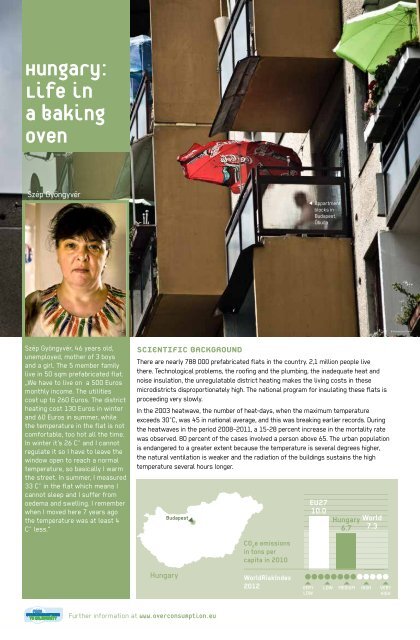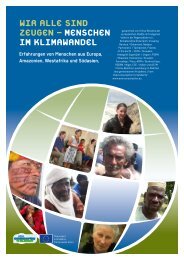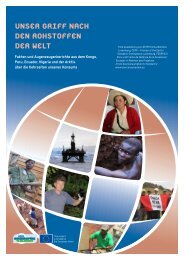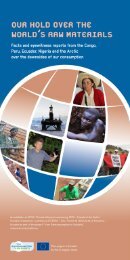WE ARE ALL WITNESSES - PEOPLE IN A CHANGING CLIMATE
The 24 panels of the "We are all witnesses - People in a Changing Climate" exhibition illustrate how climate change is already taking place in 16 countries in four countries.
The 24 panels of the "We are all witnesses - People in a Changing Climate" exhibition illustrate how climate change is already taking place in 16 countries in four countries.
You also want an ePaper? Increase the reach of your titles
YUMPU automatically turns print PDFs into web optimized ePapers that Google loves.
Hungary:<br />
Life in<br />
a baking<br />
oven<br />
Szép Gyöngyvér<br />
Appartment<br />
blocks in<br />
Budapest,<br />
Óbuda<br />
© Domaniczky Tivadar<br />
© Domaniczky Tivadar<br />
Szép Gyöngyvér, 46 years old,<br />
unemployed, mother of 3 boys<br />
and a girl. The 5 member family<br />
live in 50 sqm prefabricated flat.<br />
„We have to live on a 500 Euros<br />
monthly income. The utilities<br />
cost up to 260 Euros. The district<br />
heating cost 130 Euros in winter<br />
and 60 Euros in summer, while<br />
the temperature in the flat is not<br />
comfortable, too hot all the time.<br />
In winter it’s 26 C° and I cannot<br />
regulate it so I have to leave the<br />
window open to reach a normal<br />
temperature, so basically I warm<br />
the street. In summer, I measured<br />
33 C° in the flat which means I<br />
cannot sleep and I suffer from<br />
oedema and swelling. I remember<br />
when I moved here 7 years ago<br />
the temperature was at least 4<br />
C° less.“<br />
SCIENTIFIC BACKGROUND<br />
There are nearly 788 000 prefabricated flats in the country. 2,1 million people live<br />
there. Technological problems, the roofing and the plumbing, the inadequate heat and<br />
noise insulation, the unregulatable district heating makes the living costs in these<br />
microdistricts disproportionately high. The national program for insulating these flats is<br />
proceeding very slowly.<br />
In the 2003 heatwave, the number of heat-days, when the maximum temperature<br />
exceeds 30°C, was 45 in national average, and this was breaking earlier records. During<br />
the heatwaves in the period 2008–2011, a 15-28 percent increase in the mortality rate<br />
was observed. 80 percent of the cases involved a person above 65. The urban population<br />
is endangered to a greater extent because the temperature is several degrees higher,<br />
the natural ventilation is weaker and the radiation of the buildings sustains the high<br />
temperature several hours longer.<br />
Budapest<br />
Hungary<br />
CO 2<br />
e emissions<br />
in tons per<br />
capita in 2010<br />
WorldRiskIndex<br />
2012<br />
15<br />
14<br />
13<br />
12<br />
11<br />
10<br />
9<br />
8<br />
7<br />
6<br />
5<br />
4<br />
3<br />
2<br />
1<br />
0<br />
VERY<br />
LOW<br />
EU27<br />
10.0<br />
Hungary<br />
6.7<br />
World<br />
7.3<br />
LOW MEDIUM HIGH VERY<br />
HIGH<br />
Further information at www.overconsumption.eu









